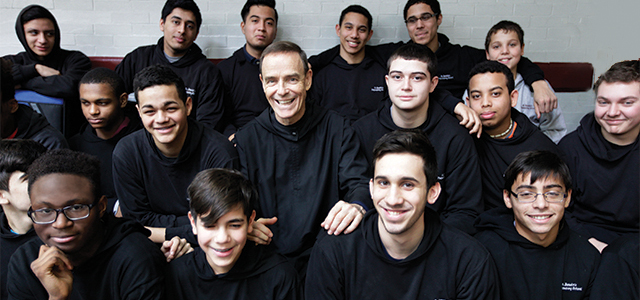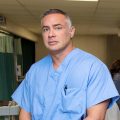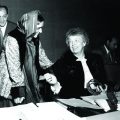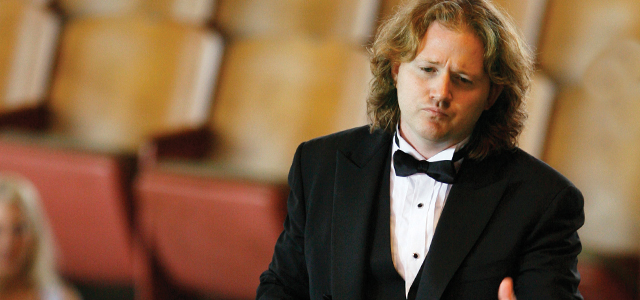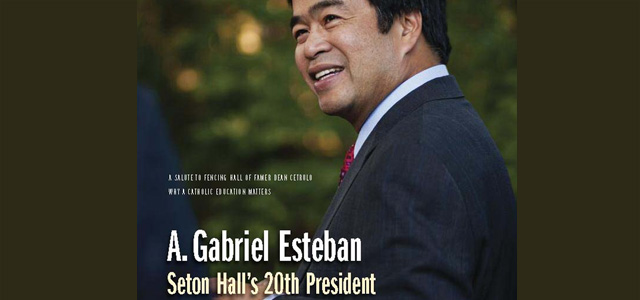The success of Father Edwin Leahy ’68 in running Saint Benedict’s Prep in Newark has generated national attention and inspired a new documentary.
When students are moving through Saint Benedict’s Preparatory School in Newark, between classes and at either end of the day, Father Edwin Leahy ’68 likes to station himself at one end of the main corridor. It is the pulpit from which he does some of his best preaching.
“You working today?” he asked one the students hurrying past from an exam, grasping his shoulder.
“Of course,” the student answered.
“That’s the way to say it,” Father Leahy said, patting him on the back and propelling him on his way.
It was the next-to-last day before Christmas break, and the traffic inside Saint Benedict’s was two-way — current students heading out, former students heading in to offer greetings to the headmaster they know as Father Ed.
“How’s school?” he asked one of the recent graduates back from his first semester at college.
“It’s a lot of work.”
“That’s the way life is, my friend,” Father Leahy said. “Come on. Courage.”
“How’re the grades?” he asked another recent graduate. “Engineering? Fighting your way through, right? That’s what you’ve got to do, fight your way through.”
Father Leahy’s voice is loud and raspy from decades of exhortations on behalf of the school where he has spent most of the last 56 years — to his fellow monks for the faith to resurrect Saint Benedict’s after it died in 1972; to alumni and other benefactors for the money to keep it alive; and to the students, most of them African-American and Latino, for the commitment demanded of them by the school that sends almost all of them to college.
“It’s a good place, because everybody’s got to go by you,” Father Leahy said of his spot in the corridor. “The worst thing they ever created in a school is the office because it gets adults tucked away from the kids.”
It’s a good place, too, because it gives him a view into the past — the spot at the far end of the corridor where he had an epiphany when he was himself a freshman.
“Something told me I was home,” he said, marking the spot where he was standing in his first week at Saint Benedict’s in 1959. A sign of more recent vintage hangs on the wall above: “It’s a Wonderful Life,” in recognition of the movie whose schoolwide screening has become an annual Christmas ritual.
“Now if I theologize about it, I guess it was the Holy Spirit.
I just had this sense that this is where I belonged.”
Founded in Newark by Benedictine monks in 1868, Saint Benedict’s educated the sons of successive waves of immigrant Catholics for more than a century. The front door on the brick building at 520 High Street, shaded by a Tiffany stained-glass awning, was their gateway to college and professional careers.

But that gateway led away from Newark for most of its graduates, and as the city changed, the school did, too: There were fewer students, and more of them were African-American. During city riots in 1967, National Guardsmen slept in the gym. Enrollment dropped further. In 1972, after years of internal dissent, 14 of the monks moved out of Newark Abbey, and the school closed. In 1973, the monks who remained reopened the school. Father Leahy, just 26 and not yet ordained, was headmaster then and is still.
“When you reflect on it now, at 69 years old, you say to yourself, ‘What the heck were you thinking?’ ” Father Leahy said. “But the anger that I had motivated me. I thought that it was just too easy for people to interpret the closing of the school and blame it on African-Americans — ‘See, here’s another great institution that goes down the chute as soon as they start going to it’ — which wasn’t the case at all. It was a problem of a lack of faith and infighting within the community.”
The school’s mission — to offer a hand up to promising boys — didn’t change after it reopened, but its methods did. The students were more often from poor families and needed more scholarships, and from broken homes and needed more extracurricular guidance. The school itself needed more help, too, which came from wealthy alumni.
Saint Benedict’s grew in both size and stature, gaining attention far beyond Newark. The 12-acre campus now straddles both sides of Dr. Martin Luther King Jr. Boulevard — the former High Street — and includes a 60-room dorm that is home to students whose own homes are plagued by too many risks. After graduation, 98 percent of the students continue directly to an array of colleges that would induce envy in guidance counselors at the wealthiest suburban high school. This incredible record recently attracted a pair of Newark-based documentary filmmakers who wanted to show the rest of the nation what it might learn from a small band of monks whose vows have bound them to a battered city.
“They’re graduating their kids and sending them to college, and a college degree means a job and a job means a reduction in poverty — that’s concrete,” said Jerome Bongiorno, who with his wife, Marylou, chronicled Saint Benedict’s in “The Rule.” The documentary, which has been showing on public television nationally since the fall, takes its title from the 6th-century Rule of Saint Benedict that guides the lives of the monks, and that has shaped the school. It is a long document, with 73 chapters, but its core values can be summarized in a few words: “Prayer and work in community,” Father Leahy said.
“We felt so strongly that this was not a story only about the school, but about the monastic influence and impact on its evolution,” Marylou Bongiorno said.
Among the vows that Benedictines take is a vow of stability. “It’s the exact opposite of most religious congregations,” Father Leahy said. “We make a commitment to a place.”
The place he committed himself to, though, was initially hesitant to commit itself to him. An honor-roll student at Saint James School in Woodbridge, he did poorly on the admission test, and his application was rejected.
“So my father goes to the pastor and he writes a letter — ‘You’ll be helping a good Catholic family and I believe you’ll be fostering a vocation,’ ” he said. “So I get in, and I’m still here.”
In high school, he was a backup quarterback on the football team, swam, wrestled and played tennis, and graduated in 1963. After a year at a Benedictine college in Alabama and another at one in Minnesota, he entered the novitiate. He spent his final two undergraduate years at Seton Hall, where he earned a bachelor’s degree in philosophy in 1968, and was disappointed that his superiors wouldn’t let him try out for the football team. He was a commuter — taking the bus in from the abbey in Newark one year, driving in from the Benedictine abbey in Morristown the other year — and the classes that stuck with him longest were the ones that challenged him the way he challenges his students now.
“Most people, when they were in his class, the first day they ran out of it, but I loved the guy,” he said of an upper-level philosophy class with Professor Vincent J. Ferrara. “He was demanding as all get-out. I appreciated his insights and I also appreciated the level of expectation he had.” Father Leahy was similarly challenged by classes in genetics and art history. “I was a little bit in over my head; I knew that, but I just loved it.”
He had no training as an educator when he became headmaster at Saint Benedict’s, but he had learned much from watching the pastor whose letter had opened the door for him, Monsignor Charles McCorristin, who ruled his parish like a mayor for three decades — greeting the merchants as he walked the downtown streets each afternoon; handing out every report card at the school; taking note of which politicians turned up at midnight Mass on Christmas.
“The town was Catholic, and he was going to make sure it stayed that way,” Father Leahy said.
Father Leahy has been similarly ubiquitous at Saint Benedict’s — presiding at his post in the corridor, patrolling the halls, cheering at the athletic events (the soccer and basketball teams are perennial powerhouses), greeting by name each of the 550 students and many of the 5,000 alumni, listening through the window of his room in the monastery, which overlooks the front door.
“They don’t know they’re telling me everything, even though I tell them, ‘Guys, watch out, I live at the front of the building,’ ” he said.
Because Saint Benedict’s has proved so good at a job that has proved so hard elsewhere — educating young men from the inner city, and steering them away from the traps that snare many of their peers — Father Leahy is often asked how other schools might do the same. “You need two things to have a chance at it,” he said: to have the people who run the school live at the school, and to be open around the clock, “like a diner.” Which sounds a lot like the Benedictine vow of stability.
“Nobody has cracked the code with young men, not even the best charter schools. We’ve probably come closer than anybody has, but we’re not knocking it out of the park every time either,” he said. “The people who think that I’m like the Delphic oracle on education, they don’t know what they’re talking about because I’m not that at all, not even close.
All I know is how to try to accompany teenagers through this part of their life. That’s all we’re trying to do here.”
This year Father Leahy has begun to step back from daily administration — he has handed off to an assistant both his office and his job of addressing the schoolwide convocation in the old gym that starts each day — to spend more time on broader tasks, like raising the $5 million in donations he needs each year to keep Saint Benedict’s solvent, and thinking about the school’s future. There are 13 monks in the abbey now, less than half the number when the school reopened.
“Will we sustain it? We won’t — God does,” he said. “I don’t know where God will lead us, but if you told me 42 years ago that I’d be sitting here, I would have said you’re out of your mind, there’s no way that’s going to happen.”
As the fall semester was ending, he also had some smaller decisions to make. For many years it has been a tradition at the school to gather in the auditorium to watch “It’s a Wonderful Life” on the last day before Christmas break. But now there was a conflict: The school’s longtime nurse had died, and her funeral was scheduled for the same time in the adjacent church. Paying respects to the dead is important in the Saint Benedict’s community; just a week earlier eight buses had taken students to Saint James in Woodbridge for the funeral of Father Leahy’s mother.
“Nobody dies on schedule,” Father Leahy said. “What the kids need to learn is that they need to respond to people’s needs and people’s grief when they have it.”
The church would not hold all the students, so he made a Solomonic decision: The older students, who had already seen the movie, would go to the church. The younger ones would go to the auditorium, where they would see just how much of a mark one man’s life can leave on others.
Kevin Coyne is a freelance writer based in New Jersey.

